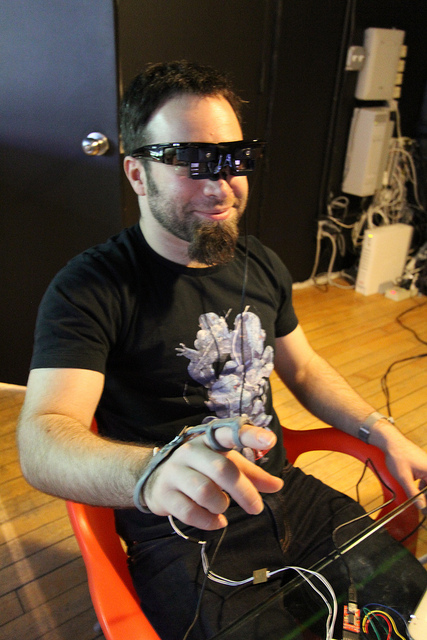In case you hadn’t noticed, there has been lots of press in the past couple of days about the rumor that Google is working on a pair of HUD glasses. I don’t doubt it, but having asked a several Googlers about this at CES, I invariably got a sarcastic reply along the lines of “yup, and we’ve also got a space elevator coming out later this year.” But I’ve never spoken to somebody from Google X. I did hear an account of Sergei Brin spending a nice chunk of time at the Vuzix booth at the show, so HUD glasses are clearly on their radar, if nothing else.
One should note that there has been mention of image analysis being performed using cloud resources in Google’s scenario. This is part of the scenario that I envisioned after hearing Microsoft’s Blaise Aguera y Arcas introduce Read/Write World at ARE. While I haven’t heard anything about it since, I wouldn’t be surprised if it pops back up this year. What I think will happen is that a wearable system will periodically upload an image to a server that will use existing photographic resources to generate a precise homography matrix pinning down the location of the camera at the time that the image was taken. The GPS metadata attached to the image will provide the coarse location fix necessary to select a relatively small dataset against which to compare the image. Moment to moment tracking will be done using a hybrid vision and sensor-based solution. But at least in the first generation of such systems, and in environments that don’t provide a reference marker, I expect cloud-based analysis to be a part of generating the ground truth against which they track.
Let’s do a little recap of some of the most notable HUD glasses options these days:
Vuzix STAR1200 – I got to try these out at ARE back in June of last year and was quite impressed. I’ve since picked up a pair and love them, with some caveats. Because they use a backlit LCD micro-displays as opposed to an emissive technology like OLEDs, you don’t get perfect transparency in areas where the signal source is sending black. That means that if the glasses are on and you are sending them a blank black screen, you still see a slight difference between the display area and your peripheral vision. Also, the field of view (FOV) of the display area could definitely stand to be a little larger. The STAR1200 is intended primarily as a research and development device, and is priced accordingly at $5000. The device comes with a plethora of connectors for different types of video sources, including mobile devices such as the iPhone. The STAR1200 is the only pair of HUD glasses that I know of that come with a video camera. The HD camera that it originally shipped with was a bit bulky, but Vuzix just started shipping units that come with a second alternate camera which is much smaller and can be swapped out. The glasses also ship with an inertial orientation tracking module. Vuzix recently licensed Nokia’s near-eye optics portfolio and will be utilizing their holographic waveguide technology in upcoming products that will be priced for the consumer market.
Lumus Optical DK-32 – I finally got to try out a Lumus product at CES, and was quite impressed. I’ve spoken with people who have tried them in the past and, based on my experience, it looks like they’ve made some advances. The FOV was considerably wider than that on the Vuzix glasses, and both contrast and brightness seemed to be marginally superior. That said, you as an individual can’t buy a display glasses product from Lumus today, and they are very selective with respect to whom they’ll sell R&D models. You can’t buy the glasses unless you’re an established consumer electronics OEM, and it would set you back $15k even if you could get Lumus to agree to sell you a pair. I’ve heard that part of the issue is the complexity of their optics manufacturing process. As I was several years ago, I’m looking forward to seeing a manufacturer turn the Lumus tech into a consumer product.
Seiko Epson Moverio BT-100 – I’m rather ashamed that I didn’t know about this device before heading to CES, and so didn’t get to hunt them down and try them. I love that these come with a host device running Android. I can’t, however, find mention of any sort of video input jack. It’s a shame if they have artificially limited the potential of these ¥59,980 ($772) display glasses. Also, with a frame that size, I’m genuinely surprised that they didn’t pack a camera in there. I’m looking forward to getting a chance to try these out.
Brother Airscouter – Announced back in 2008, Brother’s Airscouter device has found its way into an NEC wearable computer package intended for industrial applications.
I don’t mean to come off as a fanboy, but I like Vuzix a lot. This is primarily because they manage to get head-mounted displays and heads-up displays into the hands of customers despite the fact that this has consistently been niche market. I have to admire that kind of dedication to pushing for the future that we were promised. I also love that they are addressing the needs of augmented reality researchers specifically. It will be interesting to see how these rumors about Google will affect the companies that have been pushing this technology forwards for such a long time. I’m hoping that it will help broaden and legitimize the entire market for display glasses, which have long been on the receiving end of trivializing jokes on the tech blogs and their comment threads.

Pingback: Coincidental or Staged? Sergey Brin on the Subway Wears Google Glass()